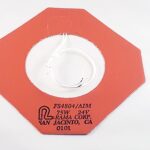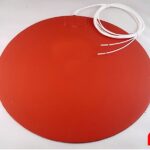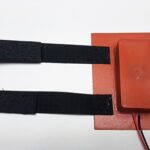USA Manufacturer of Silicone Heating Pads
Silicone heating pads are constructed from a metal heating element with coated power lines sandwiched between two sheets of silicone rubber. As a result of its lack of reactivity, silicone rubber is impervious to both water and chemicals despite its thin thickness (often 2 or 3 millimeters). Because of their low thermal mass and excellent electrical insulation, silicone heaters can produce a lot of heat in a small space and respond quickly to thermostats.
Given its high heat transfer efficiency and precision engineering, silicone heaters may be used in environments where temperatures range from -76 degrees Fahrenheit to 446 degrees Fahrenheit. Silicone heating pads come in a broad range of wattages, amperages, and power densities, making them suitable for both mild and powerful heating. They are versatile enough to be fashioned into any design imaginable, from solid to holographic to asymmetrical.
Silicone heating pads may have thermostats connected to them in two ways: temporarily and permanently. If the main controller fails, thermal fuses may be installed to save the system from overheating. Not only that, but silicone heating pads may be fastened with straps, clamped or snapped to cylindrical pieces, affixed with adhesives, magnetically held in place momentarily, or vulcanized permanently to components at the manufacturing facility.
Which Industries Use Silicone Heating Pads?
The following is a list of a few particular industries and uses for silicone heating pads:
- Petrochemical Industry: Electric heating or temperature maintenance for oil pipelines, gas transmission pipelines, valves, and other equipment.
- Chemical Industry: Electric heating or temperature maintenance for transmission pipes, reactors, processing vessels, and hot melt equipment.
- Food industry: Pipelines used to transport food must be kept at a consistent temperature, mechanical equipment must be winterized, etc.
- Automotive Industry: Electric heating or temperature maintenance for dispensing robots, windshield compound automatic glue equipment, car body, etc.
- Mechanical Engineering: Electric heating or temperature maintenance for transport containers, pumps, vacuum chambers, metering & conveying equipment, etc.
- Nuclear Power Plant: Electric heating or temperature maintenance for chimney exhaust gas analysis (exhaust gas sample sampling pipe).
Wire-Wound vs. Etched-Foil Heating Elements
Wire-wound and etched foil heating elements are the two kinds of heating elements that may be found in silicone heating pads. Each form of heating element offers a unique set of benefits.
Wire-Wound Pads
Wire wound pads employ thin resistance wires spread apart and wound around fiberglass supports. Consequently, they are the most effective choice for pads with odd shapes. They are long-lasting and, as a result, are an excellent choice for heaters that need to be removed, replaced, and reinstalled regularly. Moreover, they can be produced rapidly and affordably without special tooling, making them a perfect option for prototypes and low-volume applications.
Etched-Foil Pads
Etched foil pads are made from a sheet of foil that has been chemically etched. They heat more rapidly, have an even higher power density, and enhance heat transmission. While putting it another way, the heat they produce is more uniform, and they have a prolonged operational life. Nevertheless, they are more likely to sustain damage if bent repeatedly in the same direction. Even though they have a manufacturing process that is more extensively automated and hence more economical for high-volume projects, they incur an upfront cost for tooling.
Looking for a Silicon heating pad manufacturer?
Rama Corporation has manufactured tens of thousands of silicon heating pads for hundreds of customers over the last 75 years. We understand silicon heaters and can handle any project you may have. We offer bulk discount orders as well as custom orders.
Want to learn about how we can help you with your next project? Contact us today.






